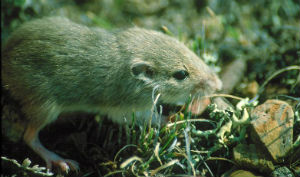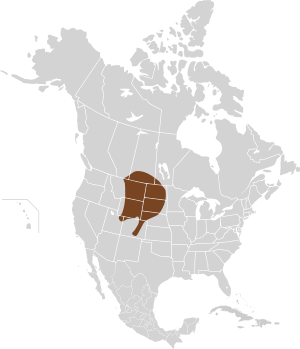Olive-backed pocket mouse facts for kids
Quick facts for kids Olive-backed pocket mouse |
|
|---|---|
 |
|
| Conservation status | |
| Scientific classification | |
| Genus: |
Perognathus
|
| Species: |
fasciatus
|
 |
|
The olive-backed pocket mouse (Perognathus fasciatus) is a small rodent that lives in the central Great Plains region of Canada and the United States. It's a common animal in these areas. The IUCN says it is of "least concern", which means it's not currently in danger of disappearing.
Contents
About the Olive-Backed Pocket Mouse
An adult olive-backed pocket mouse is usually about 12.5 to 14.3 centimeters (about 5 to 5.6 inches) long, including its tail. Its tail is about 5.6 to 6.8 centimeters (about 2.2 to 2.7 inches) long. Mice from the northern parts of their home range tend to be a bit bigger.
These tiny animals weigh about 11 to 14 grams (which is less than half an ounce!). Their fur can be dark olive-brown in the eastern areas where they live, or a pale, sandy color in the west. Their bellies are white, and a thin cream-colored line separates the darker fur on their back from the lighter fur underneath. They also have a small, buff-colored spot right behind each ear.
Where They Live
The olive-backed pocket mouse makes its home in the Great Plains of Canada and the United States. You can find them from Alberta, Saskatchewan, and Manitoba in Canada, all the way south through states like Montana, Wyoming, Utah, Colorado, and South Dakota.
They prefer dry or partly dry grasslands, especially areas with not too many plants. Sometimes, you might see them near scattered trees like aspen or cottonwood trees, or plants like fringed sagebrush. They have also been seen in sandy areas near rivers and on rocky, grassy hillsides. Their burrows, which are their underground homes, can be found in both sandy and clay soils.
What They Do
The olive-backed pocket mouse is a nocturnal animal, meaning it is active at night. During the day, it sleeps safely in its extensive underground burrow system.
Their Homes Underground
Their burrows can be quite deep, sometimes going down as far as 2 meters (about 6.5 feet). The tunnels can also spread out for about 3 meters (nearly 10 feet) on either side of the entrance!
What They Eat
These mice mostly eat seeds from different types of weeds. They have special "cheek pouches" that act like tiny shopping bags, allowing them to carry lots of seeds at once. They collect more seeds than they need right away and store the extra ones in special chambers inside their burrow. This stored food is called a "cache." They also eat some green parts of plants.
Life Cycle
Olive-backed pocket mice usually have babies during the summer months. A mother mouse typically has one or more litters, with each litter having about four to six young mice. It takes about 30 days for the babies to develop inside the mother before they are born.
Winter Sleep
In some places, these mice stay active all year. But in colder areas like Alberta, they might spend up to eight months in hibernation, which is a deep sleep during winter. Their large caches of seeds help them survive through the autumn, winter, and early spring when they don't come out of their burrows.
Scientists who studied these mice in captivity found that they hide seeds under the soil. They seem to find these hidden seeds later by smell, using their noses to probe the ground. The mice were also seen cleaning their cheek pouches by emptying them and rubbing them in the sand.
Conservation Status
The olive-backed pocket mouse is found across a wide area in Canada and the United States. It lives in many protected places and is quite common in its local areas. There are no big threats to this species, and its population seems to be stable. Because of these reasons, the IUCN has listed the species as being of "least concern". This means scientists are not worried about it becoming endangered anytime soon.
See also

- In Spanish: Perognathus fasciatus para niños


